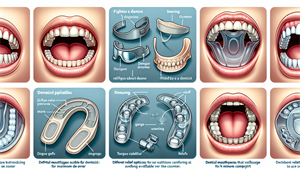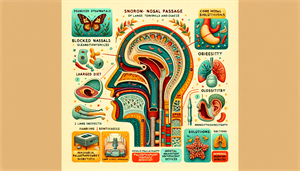
Dental Mouthpiece for Snoring
Are you or your bed partner losing sleep due to incessant snoring? If so, a dental mouthpiece for snoring could be the solution you are searching for.
Key Takeaways
-
Snoring can significantly affect sleep quality and may indicate Obstructive Sleep Apnea (OSA), a condition characterized by repeated airway blockages leading to breathing interruptions during sleep.
-
Dental mouthpieces, such as Mandibular Advancement Devices (MADs) and Tongue Retaining Devices (TRDs), are commonly used to treat snoring by repositioning the tongue or lower jaw to maintain an open airway.
-
The selection of a dental mouthpiece for snoring should consider comfort, fit, customization, adjustability, cost, and insurance coverage; consulting with a dentist for a custom-fit solution can enhance effectiveness and comfort.
Understanding Snoring and Its Impact on Sleep
Snoring is more than a mere annoyance that can disrupt a peaceful night’s sleep for you and your bed partner. It’s a sign that your body is struggling to keep its airways open during sleep. When you sleep, the muscles in your mouth, throat, and tongue relax. This can cause these tissues to vibrate as you breathe, leading to the familiar, and often disruptive, snoring sound.
Your sleeping position could also play a part in contributing to this issue. Back sleepers, for instance, are more prone to snoring because this position allows gravity to pull the relaxed tongue and soft palate into the throat, obstructing the airway and causing you to snore. Snoring can significantly impact sleep quality, leading to daytime drowsiness, irritability, and decreased productivity. More importantly, it may be a symptom of a more serious condition called obstructive sleep apnea (OSA), which can cause individuals to lose sleep.
Obstructive Sleep Apnea and Snoring: The Connection
A sleep disorder known as Obstructive Sleep Apnea (OSA) is characterized by: Frequent pauses in breathing due to partial or complete blockage of the upper airway during sleep, which differentiates it from central sleep apnea This blockage is often a result of the relaxation of throat muscles It can cause the individual to snore loudly One of the most frequent symptoms of OSA is snoring. An individual suffering from OSA might experience periods of heavy snoring followed by silence when breathing stops, then gasping or choking sounds when breathing resumes. Many individuals manage OSA and the associated snoring by using oral devices such as anti-snoring mouthpieces and anti snoring device.
These devices, like a custom mouth guard, are designed to: Fit over the upper and lower teeth Help maintain an open airway during sleep Reduce the occurrence of snoring Improve sleep quality.
Dental Mouthpieces for Snoring Relief: Types and Functions
Despite the availability of several types of dental mouthpieces, Mandibular Advancement Devices (MADs) and Tongue Retaining Devices (TRDs) are the most commonly used to treat snoring. The CustMbite Snoring System and the Thornton Adjustable Positioner (TAP) are examples of these devices that work by pulling the tongue forward or moving the lower jaw forward, respectively. This prevents the airway from getting obstructed, thereby reducing snoring episodes and helping users achieve a restful sleep.
Mandibular Advancement Devices (MADs)
Dental mouthpieces, known as Mandibular Advancement Devices (MADs) that work by moving the lower jaw forward, thereby moving the tongue forward and enlarging the retropalatal airway. This repositioning effectively decreases air resistance, increases the upper airway size, and can aid in reducing the occurrence of snoring. A variety of MADs are available, such as adjustable MADs like MyTAP, and thermoplastic ‘boil and bite’ devices. These are tailored to accommodate different needs and preferences, offering options for those seeking relief from snoring.


